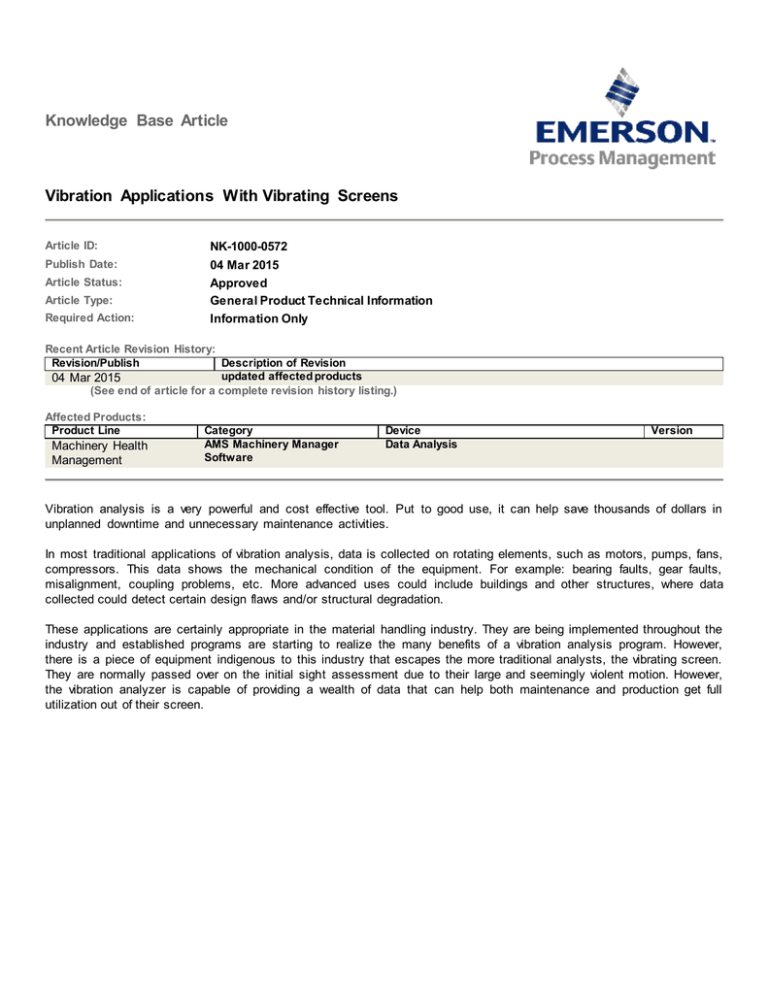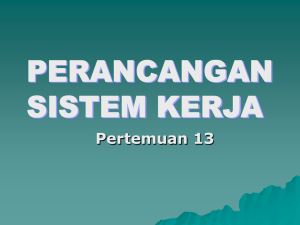
Knowledge Base Article
Vibration Applications With Vibrating Screens
Article ID:
NK-1000-0572
Publish Date:
04 Mar 2015
Approved
General Product Technical Information
Information Only
Article Status:
Article Type:
Required Action:
Recent Article Revision History:
Revision/Publish
Description of Revision
updated affected products
04 Mar 2015
(See end of article for a complete revision history listing.)
Affected Products:
Product Line
Machinery Health
Management
Category
AMS Machinery Manager
Software
Device
Data Analysis
Version
Vibration analysis is a very powerful and cost effective tool. Put to good use, it can help save thousands of dollars in
unplanned downtime and unnecessary maintenance activities.
In most traditional applications of vibration analysis, data is collected on rotating elements, such as motors, pumps, fans,
compressors. This data shows the mechanical condition of the equipment. For example: bearing faults, gear faults,
misalignment, coupling problems, etc. More advanced uses could include buildings and other structures, where data
collected could detect certain design flaws and/or structural degradation.
These applications are certainly appropriate in the material handling industry. They are being implemented throughout the
industry and established programs are starting to realize the many benefits of a vibration analysis program. However,
there is a piece of equipment indigenous to this industry that escapes the more traditional analysts, the vibrating screen.
They are normally passed over on the initial sight assessment due to their large and seemingly violent motion. However,
the vibration analyzer is capable of providing a wealth of data that can help both maintenance and production get full
utilization out of their screen.
A vibrating screen is a piece of equipment that separates different size material. Separation of material is accomplished
by means of screening media, commonly referred to as decks, which act like a filter. The screen deck has certain size
opening in it. The smaller material falls through the opening while the larger material remains on top of the screen deck.
The entire screen can vibrate at up to 1000 cycles per minute and can have as many as three decks. The decks are
arranged above each other, usually with the larger opening screen deck being on top and the lower screens having
smaller opening respectively. As material is feed onto the top deck, the screen can vibrate at over 5 G’s. The material falls
through the openings and is separated. Each deck’s overflow is usually directed into a chute and the material that falls
completely through is sent to a chute.
The screen is supported on all four corners by either steel springs or rubber “donuts” , and it can either rest on the floor or
be suspended by rods or chain. The motion of the screen is provided by an eccentric shaft. This shaft is inside a housing
that serves as the mount for the bearing. Screens can have up to three shafts, each in their respective housing.
Signal Modulation
Signal modulation is a problem when trying to get a vibration signature on the drive mechanism. The screen is moving at
a speed of up to 1000 cpm and can be producing forces in excess of 5.0 G’s. Modulated data provides little useable
information about the condition of the bearings or gears in the drive mechanism.
Typical modulated data would only appear as a single peak at turning speed. To get usable information, the modulation
would have to be corrected for as it was collected. That means that the carrier frequency would be filtered out, leaving
only the higher frequency data (impacting) of the bearings and/or gears. A technique known as PeakVue® is used in the
following example.
The “good” spectrum does contain a once per revolution impact as indicated by the peak at Turning Speed. This is nor mal
in vibrating screens due to the eccentric shaft in the drive mechanism. The “bad” spectrum contains peaks that are non synchronous to turning speed. These peaks matched the inner race fault frequency of the bearing. Note the difference in
amplitudes of the two spectra.
A normal waveform usually shows peaks of over 1 G due to the eccentric shaft, so a peak alarm of 2 G’s is chosen as an
alarm.
Traditional Screen Troubleshooting Techniques
Traditional techniques for identifying problems would include:
·
Measuring spring height
·
Checking for level spring mounts
·
Checking the level of screen (side to side)
·
·
·
·
·
Checking for evenly distributed flow from feed chute
Checking for restrictions to motion
Checking the stroke (trace of the motion)
Measuring the stroke length
Measuring screen speed
The traditional analysis of a screen’s motion, acceleration and angle is accomplished with a screen card or screen gauge.
A screen card is a rectangular, magnetic card that has several black circles of varying diameters on it. It also has several
straight lines all being at a different angles from the edge of the card. This card is placed squarely on the screen. While
the screen is running the circles will appear as an oval. The oval with the most solid center is the correct throw of the
screen. The straight line that is clearest is the proper angle of the screen. To get an idea of the orbital motion of the
screen a white sticker is applied to each corner of the screen. A pen or pencil, held firmly, lightly appl ied to the sticker,
allows the motion of the screen to be traced onto the sticker. The resulting “plot” is the motion of the screen, and the
length of the long axis of the oval is the screen’s “throw”.
The speed of the screen can be assessed with a contac t tachometer or strobe light.
The acceleration of a screen is measured with the following equation:
(Screen Speed in RPM)2 X (Screen Throw in inches) = G’sRMS
100,000
General Screen Acceleration Standards
Application
Scalping
Ballast
Aggregates
Fines
Separation
Nominal Aperture
Size (mm) of
Screening Elements
>75
75 to 32
25.4 to 6.7
<6.7
Stroke
(mm)
HD ND
12.0 - 10.5
10.0 - 8.5
9.0 - 8.0
8.0 - 7.0
Speed (rpm)
HD
ND
750 - 800
850 - 900
900 - 950
950 - 1000
G Index
(target)
Loaded
3.8
4.0
4.1
4.0
HD - Heavy Duty: Deep bed depth. high % of nearsize particles in feed, plugging or blinding is a problem.
ND - Normal Duty: Nearly optimum bed depth, avg % of nearsize particles in feed, & minimal plugging or blinding.
Orbit Analysis On Vibrating Screens
Vibration data is collected at each corner of the screen. Each corner is designated by either Feed (F) or Discharge (D)
and Left (L) or (R) . So then FL would be Feed Left, etc.
The vibration data also tells us the speed of the screen. Notice in the top right hand corner of this spectrum we see the
RPM = 998. This is accomplished through the fact that for each complete rotation of the shaft the screen makes one
complete cycle up and down. Therefore by measuring the number of cycles per minute, we know the number of shaft
rotations per minute.
Knowing what a “good” screen should look like, we can look at others and deduce that there are problems.
For example:
More Advanced Vibration Applications With Screens
It was mentioned earlier that the data needed to be collected in the vertical and horizontal planes at the same time. And to
accomplish this you would need a dual channel analyzer. This is because the data needs to be in phase to provide us with
the capability to do an Orbit Plot. An orbit plot is a plot of the relative motion between two transducers. Or in the case of a
vibrating screen it would be called the trace of the screen’s Strok e.
Why is that necessary, when we have the screens waveforms and spectra already? Because the pure waveforms and
spectra do not always alert us to everything we want to know about the motion of the screen. For example:
These 4 plots reflect what would be considered a normal screen, with nothing in the spectra or waveforms to alert a
problem.
However, if we were to plots the two waveforms simultaneously, we would see a different picture
The orbit plot can provide a wealth of data not seen in the spectra and waveforms.
It becomes easier to spot a screen with problems when we compare its orbit plot to that of a good one.
For example:
Knowing that makes it easy to spot a bad one when it looks like this:
Linking Traditional Inspections With Vibration Data
There is no doubt that linking the traditional inspections with the vibration data could provide an invaluable tool for
troubleshooting and “tuning” screen performance.
The collection of the vibration data in the vertical and horizontal planes at the same time provides us with val uable data.
First - Screen Speed
The frequency of the up and down motion of the screen is the speed of the screen.
Second - Orbit Plot
By graphing the screens vertical and horizontal vibration at the same time we get and actual trace of the motion of
the screen.
Third - Screen Angle
By treating the vertical and horizontal vibration at the speed of the screen as vectors in the x and y planes, we can
use the following equation to calculate the angle of throw of the screen.
Arctangent y/x = Angle of Throw
Fourth - Screen Force At Angle Of Incidence
Again by using the vectors we can solve for the resultant vector. Which would be the actual G’s of acceleration
that the material on the screen is seeing.
Fifth - Actual Length Of Stroke
By taking the acceleration of the resultant vector a in G’s (RMS) and converting it to displacement in Mils (Peak Peak)) at the speed of the screen, we can calculate the actual length of the stroke.
This equation is
(G’s RMS 386.4 1.414) (2 (RPM/60))2
2 = Mils Peak - Peak
Full Example Of Screen Information
Derived From Vibration Signature
Before & After Examples
Degradation Examples
Structural Problems
Structural Problems Continued
Things That Cause Bad Orbits
Installation Issues
Pedestals not equidistant from screen body
Trunion Not Level
Springs Not Plumb
Screen Not Level
Weak Column
Broken Welds
Weak Beams (Torsional Weakness)
Structural Resonance
Belts Too Tight
Motor Broke Over Center
Broken Cross Member
Weak or Broken Springs
Uneven Feed
Emerson Process Management FSOs & LBPs
Revision/Publish
04 Mar 2015
16 Dec 2010
Description of Revision
updated affected products
Original release of article
©Emerson Process Management 2009-2015. All rights reserved. For Emerson Process Management trademarks and service marks, click this link to
see trademarks. All other marks are properties of their respective owners. The contents of this publication are presented for informational p urposes
only, and while every effort has been made to ensure their accuracy, they are not to be construed as warrantees or guarantees, express or implied,
regarding the products or services described herein or their use or applicability. All sales are governed by our terms and co nditions, which are
available on request. We reserve the right to modify or improve the design or specification of such products at any time without notice.
View Emerson Products and Services: Click This Link





